BioResource Newsletter Vol.5 No.12
|
|
2009/12/28
| Information on Resource-related Events |
|
 The 3rd Rat Resource Research Workshop The 3rd Rat Resource Research Workshop
Date and Time: January 29 (Fri) 13:00 - 17:00
, 2010
Place: International Conference Hall I, Clock Tower Centennial Hall, Kyoto Univ.
 International Bioresource Symposium on Drosophila International Bioresource Symposium on Drosophila
Date: March 17 (Wed) and March 18 (Thu), 2010
Place: Enryakuji Kaikan Hotel, Enryakuji, Hieizan
Details are available at: http://www.nbrp.jp/
|
|
| Research and Bioresources No.7 |
|
 Brain Research using Nihonzaru (Japanese macaques) Brain Research using Nihonzaru (Japanese macaques)
Tadashi Isa, Professor
National Institute for Physiological Sciences (NIPS) |
 |
|
|
Introduction
Macaque monkeys, including Nihonzaru(Macaca fuscata), have been extensively used as experimental animals in research related to higher brain functions, infections and immunology, and tissue engineering because they share several characteristics with humans. Nihonzaru are indigenous to Japan, and they are highly curious and gentle. The genetic variability in the Nihonzaru is lesser than that in other macaque monkeys. Carlsson, et al. * investigated the use of primates in various fields of research and found that among the 2783 journal articles published in 2001 that pertain to the use of cercopithecine monkeys, the number of articles pertaining to the use of Nihonzaru, rhesus macaques, and crab-eating monkeys were 93, 793, and 369, respectively. This finding shows that the usefulness of Nihonzaru in research is relatively low. However, a research-wise break-up of primate use showed that the Nihonzaru were more frequently used in neuroscience and physiology (41% and 18%, respectively) research than the rhesus macaques (32% and 5%, respectively) and crab-eating monkeys (37% and 4%, respectively). We also investigated the source of research articles in Primate Lit, a database of academic journal articles, and found that approximately 70% of the articles published in 2001 pertaining to the use of Nihonzaru were published by institutions in Japan. In addition, most of the research articles pertaining to the use of Nihonzaru, whose numbers are on the rise since 1980, were based on studies conducted in Japan. This finding also indicates that Nihonzaru have been widely used in life science research, particularly neuroscience and physiology research, in Japan.
* Carlsson, Hans-Erik et al. 2004 Use of Primates in Research: A Global Overview. American Journal of Primatology 63:225-237.
|
|
|
Status of Resource Maintenance
To date, approximately 10,000 wild Nihonzaru have been captured under the pretext of controlling harmful wildlife, and a fraction of the captured monkeys have been used for research. Although some people consider the use of wild animals for research as unethical, researchers require a steady supply of healthy monkeys to be used as experimental animals.Therefore, a group of researchers, particularly in the field of brain science, was eager to establish a breeding center for monkeys. As a result, Japanese macaques Bioresource Project was initiated in 2002 with multidisciplinary collaborations. Tremendous effort has been put into this project, and consequently, the number of monkeys in the reproduction group was 677 and the nurtured group was 269 as of March 31, 2009. In the fiscal year 2009, a total of 67 monkeys will be supplied to 20 institutions. In future, we aim to improve our supply system so that more than 100 monkeys can be distributed per year by the fiscal year 2011.
|
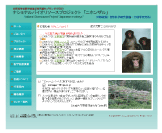
NBRP "Japanese macaques" Website
http://www.macaque.nips.ac.jp/ (japanese only) |
|
|
Brain Research using Nihonzaru
Nihonzaru are frequently used in various cutting-edge studies in Japan, particularly in the field of neuroscience research; these monkeys are generally used to study higher brain functions such as sophisticated motor controls, perception, learning, and memory and as models to study functional recovery after brain or spinal cord injury (Fig. 1).
|
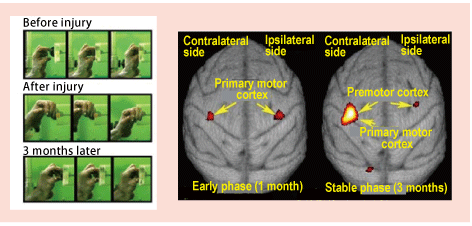
Fig. 1: The recovery process after spinal cord injury (left) and brain activity during early recovery phase (1 month after injury) and plateau phase of recovery (3 months after injury) of fingers. The activity of the primary motor cortex on both sides increased in the early phase, and the activity of an extensive region of the primary motor cortex on the contralateral side of the injury and the premotor cortex on both sides also increased (Isa, et al., Science 2007).
|
|
|
|
|
Iriki, et al. recently reported a unique research result in RIKEN. They observed that the visual receptive field of the neural cells in a certain area of the parietal association cortex is enlarged from fingers to the tip of tools in Nihonzaru that learned the use of tools. In other words, a tool is assimilated into the monkey’s body schema. The recent study also reported an increase in the volume of gray matter in the cerebral cortex during this process (Fig. 2).
An increasing number of journal articles have recently reported drastic development and differentiation of primate genes, particularly those genes expressed in a certain area of the brain cortex. Yamamori, et al. first discovered this gene, which is specifically expressed in the primary visual cortex in the brain cortex of Nihonzaru, and named it OCC-1. It was found that OCC-1 expression was controlled by activity and that it was expressed in the visual cortex of macaque monkeys and common marmosets but not of rodents (Fig. 3). Recently, Higo, Kojima, and Isa, et al. discovered a gene SPP-1, which is selectively expressed in the corticospinal tract cells in the brain cortex of macaque monkeys. This gene was expressed in the brain cortex of macaque monkeys and New World monkeys, such as white-fronted capuchin, which show high finger dexterity, but not of rodents. Furthermore, the gene is not expressed in common marmosets, which are also New World monkeys but with slightly lesser finger dexterity; therefore, the gene is presumably associated with highly sophisticated finger dexterity, particularly the presence or absence of direct associations between the corticospinal tract cells and motor neurons, which play a fundamental role in affording dexterity. Japan is currently a world leader in research on genes that are specifically expressed in the primate brain cortex. Controlled gene expression techniques using virus vectors could be used in the future to conduct functional analysis of these genes.■
|
|
|
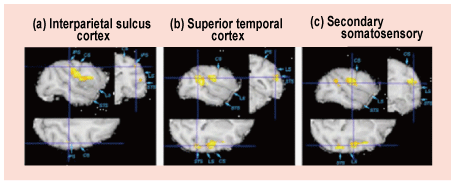
Fig. 2: Nihonzaru that underwent a 2-week tool-use training showed an enlargement of certain brain regions, and the degree of enlargement corresponded with their proficiency in tool use. (Iriki, et al., PNAS (2009)). |
|
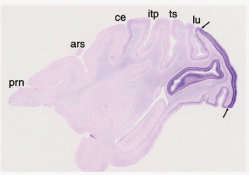
Fig. 3: Visualization of occ1 expressed in the brain cortex of Nihonzaru by in-situ hybridization. The gene is selectively expressed in primary visual cortex (Yamamori, et al., Eur J Neurosci, 2001). |
|
|
|
|

|
Erudite Lecture Series by Dr. Benno: No. 12 (final episode) |
|
|
|
What is defecation ability ?
Production of Feces: We need to exercise wisdom while consuming foods. It is important to comprehend the essence and constituents of foods. Foods play an important role when we are confronted with various risks such as developing diseases. Instead of following trends or styles of food consumption, it is important to consume foods that are beneficial to our health.
|

|
Nurturing Feces: Fecal matter contains water (80%) and solids (20%). Enteric bacteria account for 50% of the solid content of feces. Therefore, enteric bacteria account for 10% of the total mass of feces. Maintenance of this enteric bacterial mass is crucial to healthy living. The food remnants in the colon serve as a banquet for these bacteria. Although food remnants are considered to be a waste by humans, the remnants serve as food for the enteric bacteria. Human waste is a "gift from the land" for the bacteria. Moreover, Western dietary habits have made the banquet even more attractive to harmful bacteria. Our diet will determine whether beneficial or harmful bacteria are predominant in our colons.
Excretion of Feces: Constipation is generally experienced by people who tend to dislike exercising. In other words, those who retain feces in the colon tend to develop constipation. While all the organisms excrete food wastes, humans tend to store them in the colon. To be exact, humans sometimes cannot smoothly excrete their wastes. If animals experience constipation, their body odor becomes stronger, and this will increase the chance of being detected by their predators . Elimination of body odor is important for animals to escape predators. |
People who experience constipation lack sufficient force to excrete feces. In other words, the muscles lining the walls of the colon are extremely weak in these people. It is very important to retain the muscular strength necessary to expel feces, and regular exercising helps strengthen these muscles.
The acquisition of good "defecation ability" is a shortcut to enjoying a healthy and long life. In this manner, "defecation ability" is measurable and is closely associated with our health and longevity.
|

|
| |
|
|
 Systems Biology Graphical Notation
(SBGN) Systems Biology Graphical Notation
(SBGN)
Systems biology, a field of science that aims to understand the complex interactions in biological systems, has made tremendous advancements in the recent years. An international standard of graphical representation to describe biological networks was recently developed by approximately 30 institutions both within and outside Japan. This graphical representation is called the Systems Biology Graphical Notation (SBGN), and the details were published in the August issue of Nature Biotechnology (*1). Methods to graphically represent interactions between molecules and genes have existed even before the development of SBGN; however, these representations were inconsistent and not precisely defined, thereby causing occasional misunderstandings. It is expected that the use of SBGN may resolve this issue.
|
|
SBGN is currently classified into the following 3 representation schemes: SBGN Process Description for the representation of state transition,SBGN Entity Relationship for the associations, and SBGN Activity Flow for activities. Please refer to the website, http://www.sbgn.org/Main_Page, for more details regarding SBGN.
|

|
Next, we introduce the "TexFlame" tool. "TexFlame" is a tool that renders a PubMed abstract into a graphical representation derived from the SBGN. You can use this tool via their website (http://texflame.com/) or you can install a Firefox add-on (*2). From their website, type the PubMed ID in the "Enter PMID" textbox and press "Render". If you are using the Firefox add-on, open the PubMed abstract in your Firefox browser and click on the "TexFlame" icon displayed on the bottom right of your browser.
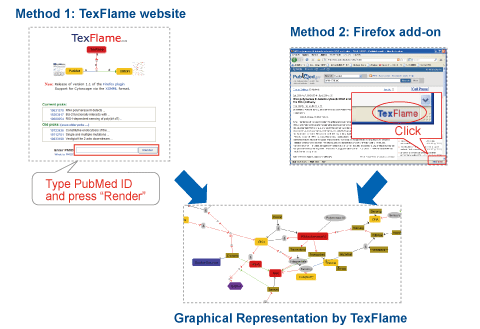
Please refer to the website, http://texflame.com/Help.html, for more details about graphical representation by TexFlame. This tool enables users to visualize the contents of an abstract; thereby it should help to deepen their understanding of the article.
*1: Nature Biotechnology 2009 27(8):735-41.
*2: The Firefox add-on can be downloaded from the following website: https://addons.mozilla.org/en-US/ firefox/addon/15047
(Yuka Takahashi and Rie Tsuchiya)
|
|
Editor's Note: We have introduced topics pertaining to primates, such as "human-derived bioresources" (June issue), common marmosets (September issue), chimpanzees (October issue), and Nihonzaru (December issue), which we had not covered in previous issues. Bioresource projects that support fundamental scientific research in Japan have been gaining wide acceptance in the scientific communities. Dr. Benno's lecture series concludes with this issue, and we appreciate Dr. Benno for his contributions throughout the year. We wish all the readers a healthy and prosperous new year. (Y.Y.)
|
Contact Address:
1111 Yata, Mishima-shi, Shizuoka 411-8540, Japan
Center for Genetic Resource Information, National Institute of Genetics
Tel: 055-981-6885 (Yamazaki)
E-mail brnews@chanko.lab.nig.ac.jp
"translated by ASL translation service and proofread by Sharoh Yip"
|
|











